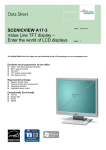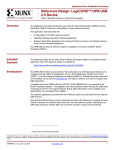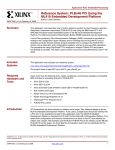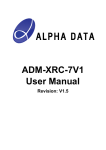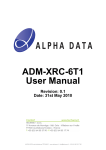Download User manual
Transcript
ADM-XRC-5LX PCI Mezzanine Card User Guide Version 2.0 ADM-XRC-5LX User Manual Copyright © 2006, 2007, 2008 Alpha Data Parallel Systems Ltd. All rights reserved. This publication is protected by Copyright Law, with all rights reserved. No part of this publication may be reproduced, in any shape or form, without prior written consent from Alpha Data Parallel Systems Limited Alpha Data 4 West Silvermills Lane Edinburgh EH3 5BD UK Alpha Data 2570 North First Street, Suite 440 San Jose, CA 95131 USA Phone: Fax: Email: Phone: (408) 467 5076 Fax: (866) 820 9956 Email: [email protected] +44 (0) 131 558 2600 +44 (0) 131 558 2700 [email protected] ADM-XRC-5LX User Manual Version 2.1 ADM-XRC-5LX User Manual Table of Contents 1. 2. 3. 4. 5. 6. Introduction ........................................................................................................................1 1.1. Specifications ............................................................................................................1 Hardware Installation .........................................................................................................2 2.1. Motherboard requirements........................................................................................2 2.2. Handling instructions.................................................................................................2 2.3. Installing the ADM-XRC-5LX onto a PMC motherboard...........................................2 2.4. Installing the ADM-XRC-5LX if fitted to an ADC-PMC..............................................2 Software Installation...........................................................................................................2 Board Description ..............................................................................................................3 4.1. Local Bus...................................................................................................................4 4.2. Flash Memory............................................................................................................5 4.2.1. Board Control Flash..........................................................................................5 4.2.2. User FPGA Flash .............................................................................................5 4.3. Health Monitoring ......................................................................................................5 4.4. JTAG .........................................................................................................................6 4.5. Clocks........................................................................................................................7 4.5.1. LCLK.................................................................................................................7 4.5.2. MCLK................................................................................................................8 4.5.3. REFCLK ...........................................................................................................8 4.5.4. XRM Clocks......................................................................................................8 4.5.5. Rear (Pn4) Clocks ............................................................................................8 4.5.6. PCI Clocks........................................................................................................9 4.6. User FPGA ................................................................................................................9 4.6.1. Configuration ....................................................................................................9 4.6.2. I/O Bank Voltages.............................................................................................9 4.6.3. Memory Interfaces..........................................................................................10 4.7. XRM Bus and Front Panel I/O.................................................................................11 4.7.1. XRM Signalling Voltage..................................................................................11 4.7.2. XRM Interface – Connector Pinout.................................................................12 4.8. Pn4 I/O ....................................................................................................................15 4.8.1. Pn4 Signalling Voltage ...................................................................................16 XRM IO146 Interface .......................................................................................................17 Revision History ...............................................................................................................19 ADM-XRC-5LX User Manual Version 2.1 ADM-XRC-5LX User Manual Table of Tables Table 1 Local Bus Interface Signal List .................................................................................... 4 Table 2 Voltage and Temperature Monitors............................................................................. 6 Table 3 XRM Bus Regional Clocks .......................................................................................... 8 Table 4 Rear (Pn4) Regional Clocks........................................................................................ 8 Table 5 User FPGA I/O Bank Voltages .................................................................................... 9 Table 6 DDR Memory Bank Configuration ............................................................................. 10 Table 7 XRM I/O Voltage Selection........................................................................................ 11 Table 8 XRM Interface - part 1 ............................................................................................... 12 Table 9 XRM Interface - part 2 ............................................................................................... 13 Table 10 XRM Interface - part 3 ............................................................................................. 14 Table 11 Pn4 to FPGA Assignments...................................................................................... 15 Table 12 Pn4 Voltage Selection ............................................................................................. 16 Table 13 IO146 Mictor Connector Pins 1 - 38........................................................................ 17 Table 14 IO146 Mictor Connector Pins 39 - 76...................................................................... 17 Table 15 IO146 Mictor Connector Pins 77 – 114 ................................................................... 18 Table 16 IO146 Mictor Connector Pins 115 - 152.................................................................. 18 Table of Figures Figure 1 Figure 2 Figure 3 Figure 4 ADM-XRC-5LX Block Diagram .................................................................................. 3 Local Bus Interface .................................................................................................... 4 JTAG Header ............................................................................................................. 6 Clock Structure........................................................................................................... 7 ADM-XRC-5LX User Manual Version 2.1 ADM-XRC-5LX User Manual 1. Introduction The ADM-XRC-5LX is a high performance PCI Mezzanine Card (PMC) designed for supporting development of applications using the Virtex-5LX series of FPGAs from Xilinx. The card uses an FPGA PCI bridge developed by Alpha-Data supporting PCI-X and PCI. A high-speed multiplexed address/data bus connects the bridge to the target (user) FPGA. 1.1. Specifications The ADM-XRC-5LX supports high performance PCI-X / PCI operation without the need to integrate proprietary cores into the user FPGA. • Physically conformant to IEEE P1386-2001 Common Mezzanine Card standard • High performance PCI and DMA controllers • Local bus speeds of up to 80 MHz • Four banks of 64Mx32 DDRII SDRAM (1GB total) • User clock programmable between 20MHz and 500MHz • Stable low-jitter 200MHz clock for precision IO delays • User front panel adapter with up to 146 free IO signals • User rear panel PMC connector with 64 free IO signals • Programmable 2.5V or 3.3V I/O on front and rear interfaces • Supports 3.3V PCI or PCI-X at 64 bits ADM-XRC-5LX User Manual Version 2.0 Page 1 ADM-XRC-5LX User Manual 2. Hardware Installation This chapter explains how to install the ADM-XRC-4 (LX/SX) onto a PMC motherboard. 2.1. Motherboard requirements The ADM-XRC-5LX supports 3.3V only signalling on the PCI Bus. It is not compatible with systems that use 5V signalling. The ADM-XRC-5T1 must be installed in a PMC motherboard that supplies +5.0V and +3.3V power to the PMC connectors. Ensure that the motherboard satisfies this requirement before powering it up. +12V and -12V may also be required for certain XRM modules. 2.2. Handling instructions Observe SSD precautions when handling the cards to prevent damage to components by electrostatic discharge. Avoid flexing the board. 2.3. Note: Installing the ADM-XRC-5LX onto a PMC motherboard This operation should not be performed while the PMC motherboard is powered up. The ADM-XRC-4 (LX/SX) must be secured to the PMC motherboard using M2.5 screws in the four holes provided. The PMC bezel through which the I/O connector protrudes should be flush with the front panel of the PMC motherboard. 2.4. Installing the ADM-XRC-5LX if fitted to an ADC-PMC The ADM-XRC-4 (LX/SX) can be supplied for use in standard PC systems fitted to an ADCPMC carrier board. The ADC-PMC can support up to two PMC cards whilst maintaining host PC PCI compatibility. If you are using a ADC-PMC refer to the supplied documentation for information on jumper settings. All that is required for installation is a PCI slot that has enough space to accommodate the full-length card. The ADC-PMC is compatible with 5V and 3V PCI (32 and 64 bit) and PCI-X slots. It should be noted that the ADC-PMC uses a standard bridge to provide a secondary PCI bus for the ADM-XRC-4 (LX/SX) and that some older BIOS code does not set up these devices correctly. Please ensure you have the latest version of BIOS appropriate for your machine. 3. Software Installation Please refer to the SDK installation CD. The SDK contains drivers, examples for host control and FPGA design and comprehensive help on application interfacing. ADM-XRC-5LX User Manual Version 2.0 Page 2 ADM-XRC-5LX User Manual 4. Board Description The ADM-XRC-5LX follows the architecture of the ADM-XRC series and decouples the “target” FPGA from the PCI interface, allowing user applications to be designed with minimum effort and without the complexity of PCI design. A separate Bridge / Control FPGA interfaces to the PCI bus and provides a simpler Local Bus interface to the target FPGA. It also performs all of the board control functions including the configuration of the target FPGA, programmable clock setup and the monitoring of on-board voltage and temperature. DDR2 SDRAM and serial flash memory connect to the target FPGA and are supported by Xilinx or third party IP. IO functionality is provided using XRM modules connecting to a 180 pin SAMTEC QSH connector. Flash Memory (16MB) Bridge Config Pn1 Pn2 Pn3 PCI-X / PCI64/66 Pn4 Bridge / Control FPGA Virtex4 LX25 Programmable Clocks Local Bus (64 bit) User FPGA Virtex5 LX50/80/110 Serial Flash (4MB) Rear I/O (64 bit) JTAG System Monitor (LM87) Power Conversion DDR2 SDRAM (256MB) DDR2 SDRAM (256MB) Figure 1 ADM-XRC-5LX Block Diagram ADM-XRC-5LX User Manual Version 2.0 Page 3 XRM Bus (146 bit) DDR2 SDRAM (256MB) DDR2 SDRAM (256MB) Front I/O (XRM) ADM-XRC-5LX User Manual 4.1. Local Bus The ADM-XRC-5LX implements a multi-master local bus between the bridge and the target FPGA using a 32- or 64-bit multiplexed address and data path. The bridge design is asynchronous and allows the local bus to be run faster or slower than the PCI bus clock to suit the requirements of the user design. PCI Bus Bridge/Control FPGA Virtex4 LX25 lad_l[63:0] lbe_l[7:0] lads_l lblast_l lbterm_l lready_l lwrite ldreq_l[3:0] ldack_l[3:0] User FPGA Virtex5 LX55/80/110 fhold fholda lreset_l lclk Figure 2 Local Bus Interface Signal lad[0:63] lbe_l[0:7] lads_l lblast_l lbterm_l lready_l lwrite ldreq_l[0:3] ldack_l[0:3] fhold fholda lreset_l lclk Type bidir bidir bidir bidir bidir bidir bidir unidir unidir unidir unidir unidir unidir Purpose Address and data bus. Byte qualifiers Indicates address phase Indicates last word Indicates ready and requests new address phase Indicates that target accepts or presents new data Indicates a write transfer from master DMA request from target to bridge DMA acknowledge from bridge to target Target bus request Bridge bus acknowledge Reset to target Clock to synchronise bridge and target Table 1 Local Bus Interface Signal List ADM-XRC-5LX User Manual Version 2.0 Page 4 ADM-XRC-5LX User Manual 4.2. Flash Memory The ADM-XRC-5LX is fitted with two separate Flash memories: one connected to the Bridge / Control FPGA and the other to the User FPGA. 4.2.1. Board Control Flash An Intel PC28F256P30 flash memory is used for storing a configuration bitstream for the User FPGA. Once the Bridge / Control FPGA is configured, it checks for a valid bitstream in flash and, if present, automatically loads it into the User FPGA. This process can be inhibited by setting a jumper on the JTAG connector. See the description of the “FBS” signal in Section 4.4 for further information. Access to this flash device is only possible through control logic registers. The flash is not directly mapped onto the local bus. Programming, erasing and verification of the flash are supported by the ADM-XRC SDK and driver. Utilities are provided to load bitstreams into the flash. These also verify the bitstream is compatible with the target FPGA. 4.2.2. User FPGA Flash An ST M25P32 flash memory with SPI interface is connected to the User FPGA for the storage of application-specific information. Note: This device is not connected to the SPI configuration pins on the User FPGA and cannot be used for configuration. 4.3. Health Monitoring The ADM-XRC-5LX has the ability to monitor temperature and voltage of key parts of the PMC to maintain a check on the operation of the board. The monitoring is implemented by a National Semiconductor LM87 and is supported by the board control logic connected using I2C. The Control Logic scans the LM87 when instructed by host software and stores all current voltage and temperature measurements in a blockram. This allows the values to be read without the need to communicate directly with the monitor. The following supplies and temperatures, as shown in Table 2, are monitored. ADM-XRC-5LX User Manual Version 2.0 Page 5 ADM-XRC-5LX User Manual Monitor 1.0V 1.2V 1.8V 2.5V 5.0V PCI_VIO XRM_VCCI O Temp1 Temp2 Purpose User FPGA Core Supply Bridge FPGA Core Supply Memories, User FPGA Memory I/O, Local Bus I/O Config CPLD Core Supply Source voltage for Front, Rear I/O Board Input Supply Monitors the PCI signalling supply – VIO Either 2.5V or 3.3V Front Panel I/O Voltage User FPGA die temperature LM87 on die temperature for board/ambient Table 2 Voltage and Temperature Monitors An application is provided in the SDK that permits the reading of the health monitor. The typical output of the monitor is shown below, provided by the SYSMON program. 4.4. JTAG A JTAG header is provided to allow download of the FPGA using the Xilinx tools and serial download cables. This also allows the use of ChipScope PRO ILA to debug an FPGA design. It should be noted that four devices will be detected when the SCAN chain is initialised. TMS TDI TDO TCK FBS GND VCC Figure 3 JTAG Header The VCC supply provided on J5 to the JTAG cable is +2.5V and is protected by a poly fuse with a rating of 350mA. FBS The FBS signal is an input to the control logic and provides control of the cold boot process. By default with no link fitted, the control logic will load a bitstream from flash into the FPGA if one is present. Shorting FBS to the adjacent GND pin will disable this process and can be used to recover situations where rogue bitstreams have been stored in flash. ADM-XRC-5LX User Manual Version 2.0 Page 6 ADM-XRC-5LX User Manual 4.5. Clocks The ADM-XRC-5LX is provided with numerous clock sources, as shown in Figure 4 below: PCI Bus PCI RefClk PCI-X CLK Bridge Cfg Ctl (Coolrunner) 25.0 MHz Osc PCI CLK Bridge FPGA (V4LX25) REFCLK_200M Ctl LCLK 25.0 MHz XTAL 200 MHz Osc. Local Bus ICS8430 MCLK MCLK XRM_CLKIN XRM Connector (Samtec) Zero-delay Buffer (PLL) Pn4 Connector User FPGA V5LX55/80/110 FF1153 CLK0 (P) CLK1 (N) CLK2 (P) CLK3 (N) CLK4 (P) KEY CLK5 (N) Global Clock Inputs Clock Capable I/O CLK6 (P) CLK7 (N) Figure 4 Clock Structure 4.5.1. LCLK The Local Bus can be used at up to 80 MHz and all timing is synchronised to LCLK between the Bridge and User FPGAs. LCLK is generated from a 200MHz reference by a DCM within the bridge FPGA. The minimum LCLK frequency (determined by the DCM specification) is 32MHz. The LCLK frequency is set by writing to the board control logic. (See SDK for details and example application). Note: If the user FPGA application includes a DCM driven by LCLK (or one of the other programmable clocks), the clock frequency should be set prior to FPGA configuration. ADM-XRC-5LX User Manual Version 2.0 Page 7 ADM-XRC-5LX User Manual 4.5.2. MCLK MCLK is an LVPECL clock generated by an ICS8430-61 synthesiser with a base 25MHz crystal. The synthesiser has two outputs of the same clock, one of which is routed to the User FPGA whilst the other is routed to the XRM connector. Both are terminated using LVPECL terminations. MCLK can be programmed to between 20MHz and 500MHz. 4.5.3. REFCLK In order to make use of the IODELAY features of Virtex™-5, a stable low-jitter clock source is required to provide the base timing for tap delay lines in each IOB in the User FPGA. The ADM-XRC-5LX is fitted with a 200MHz LVPECL (LVDS optional) oscillator connected to global clock resource pins. This reference clock can also be used for application logic if required. 4.5.4. XRM Clocks Global Clock Input The XRM interface provides a differential input to the User FPGA global clocking resources. The default on-board terminations are suitable for an LVPECL clock. Regional Clocks The XRM interface provides 8 clock lines that can be either be used single-ended or as 4 LVDS differential pairs. These clocks are routed to Clock-Capable I/O on the User FPGA, providing access to its regional clock capabilities. Each clock pair is in a different clock region alongside 16 pairs of XRM bus signals, as shown in Table 3 below: XRM Clocks 0 & 1 (Pair 0) 2 & 3 (Pair 1) 4 & 5 (Pair 2) 6 & 7 (Pair 3) FPGA Bank 26 22 18 14 XRM bus pairs 1 – 16 17 – 32 33 – 48 49 – 64 Table 3 XRM Bus Regional Clocks 4.5.5. Rear (Pn4) Clocks There are no dedicated clock lines between the Pn4 connector and the user FPGA. However, the following signal pairs are routed to clock-capable I/O on the User FPGA, providing access to its regional clock capabilities. FPGA Bank 11 13 Pn4 bus pairs 22, 23, 24 & 25 6, 7, 8 & 9 Table 4 Rear (Pn4) Regional Clocks ADM-XRC-5LX User Manual Version 2.0 Page 8 ADM-XRC-5LX User Manual 4.5.6. PCI Clocks The PCI Interface within the bridge FPGA requires a regional clock input for 66MHz PCI operation or a global clock input for PCI-X. To comply with the single-load requirement in the PCI specification, a zero-delay clock buffer is used to route the PCI clock to the two different clock inputs. The clock buffer has a PLL with a minimum input frequency of 24MHz, potentially causing problems in applications that use the PCI 33MHz mode with a slow clock. In this case, the buffer can be removed to provide full PCI 33MHz compatibility. 4.6. User FPGA 4.6.1. Configuration The ADM-XRC-5LX performs configuration from the host at high speed using SelectMAP. The FPGA may also be configured from flash or by JTAG via header J5. Download from the host is the fastest way to configure the User FPGA with 8 bit SelectMAP mode enabled. This permits a configuration speed of up to 40MB/s. The ADM-XRC-5LX can be configured to boot the User FPGA from flash on power-up if a valid bit-stream is detected in the flash. Booting from flash will also configure the clocks and I/O voltages as appropriate. 4.6.2. I/O Bank Voltages Bank 0 5, 12, 15, 16, 19, 20, 23, 24 2 3, 4 11, 13 14, 18, 26, 22 6, 17, 21, 25 Voltage 2.5V 1.8V 1.8V 3.3V 2.5V or 3.3V 2.5V or 3.3V 1.8V Description Configuration I/F DDRII DRAM I/O SelectMAP I/F Clocks, Serial Flash Pn4 Interface XRM Interface Local Bus Table 5 User FPGA I/O Bank Voltages ADM-XRC-5LX User Manual Version 2.0 Page 9 ADM-XRC-5LX User Manual 4.6.3. Memory Interfaces The ADM-XRC-5LX has 4 independent banks of DDRII SDRAM. Each bank consists of two memory devices in parallel to provide a 32 bit datapath. 1Gb Micron MT47H64M16 devices are fitted as standard to provide 256MB per bank. The board will support higher capacity devices when they become available. Details of the signalling standards, bank numbers etc. are given in the tables below: Name Direction I/O Standard DDR1_ad[15:0], DDR1_ba[2:0], DDR1_rasn, DDR1_casn, DDR1_wen, DDR1_csn, DDR1_cke, DDR1_odt DDR1_ck0, DDR1_ckn0 DDR1_dq[15:0] DDR1_dm[1:0] DDR1_dqs[1:0], DDR1_dqsn[1:0] DDR1_ck1, DDR1_ckn1 DDR1_dq[31:16] DDR1_dm[3:2] DDR1_dqs[3:2], DDR1_dqsn[3:2] DDR1_read_en_out DDR1_read_en_in Output SSTL18_I Output DIFF_SSTL18_II BiDir Output BiDir SSTL18_II SSTL18_I DIFF_SSTL18_II Output DIFF_SSTL18_II BiDir Output BiDir SSTL18_II SSTL18_I DIFF_SSTL18_II Output Input Table 6 DDR Memory Bank Configuration ADM-XRC-5LX User Manual Version 2.0 Page 10 ADM-XRC-5LX User Manual 4.7. XRM Bus and Front Panel I/O A major benefit of the ADM-XRC series of boards that use the XRM Bus interface is the versatility of I/O options that result. The ADM-XRC-5LX maintains this interface and thus compatibility with a wide range of I/O modules to suit many diverse needs. The XRM interface uses the 180 pin Samtec QSH series connector, CN1. 4.7.1. XRM Signalling Voltage The signalling voltage on the XRM connector (and User FPGA Banks 14, 18, 22 & 26) is selectable by jumper J6. J6 Link p1 & p2 Link p3 & p4 Link p5 & p4 XRM I/O voltage 3.3V 2.5V 1.8V Table 7 XRM I/O Voltage Selection ADM-XRC-5LX User Manual Version 2.0 Page 11 ADM-XRC-5LX User Manual 4.7.2. XRM Interface – Connector Pinout The XRM interface is implemented on CN1, a 180 pin Samtec connector type QSH, with the pin-out as detailed in tables Table 8 to Table 10. In turn, the signals that connect to CN1 are provided in the main from three banks of the User FPGA, Banks 9, 11 and 13. These banks share a common VCCO that can be 2.5V or 3.3V powered, selectable under user control. Signal N_1 P_1 N_3 P_3 N_5 P_5 N_7 P_7 P_9 N_9 N_11 P_11 N_13 P_13 N_15 P_15 N_17 P_17 WIRE_S_1 +3.3V +3.3V +3.3V +5V +5V VBAT +12V +12V PRESENCE_L XRM_TCK XRM_TMS FPGA Pin AL6 AL5 AL4 AM5 AM6 AN7 AN8 AN9 AP7 AP6 AM17 AN17 AP12 AP11 AN14 AP14 AA11 AA10 AL8 Samtec Pin 1 3 5 7 9 11 13 15 17 19 21 23 25 27 29 31 33 35 37 39 41 43 45 47 49 51 53 55 57 59 Samtec Pin 2 4 6 8 10 12 14 16 18 20 22 24 26 28 30 32 34 36 38 40 42 44 46 48 50 52 54 56 58 60 FPGA Pin AN4 AN5 AP5 AP4 AM7 AM8 AL10 AM10 AN10 AM11 AP17 AP16 AM15 AM16 AP15 AN15 AA9 AA8 AP9 AP10 Table 8 XRM Interface - part 1 ADM-XRC-5LX User Manual Version 2.0 Page 12 Signal N_2 P_2 P_4 N_4 N_6 P_6 N_8 P_8 P_10 N_10 N_12 P_12 P_14 N_14 P_16 N_16 N_18 P_18 CLK0 CLK1 XRM_SERID RESERVED XRM_VREF XRM_VCCIO XRM_VCCIO XRM_VCCIO -12V XRM_TDI XRM_TRST XRM_TDO ADM-XRC-5LX User Manual Signal N_19 P_19 N_21 P_21 N_23 P_23 N_25 P_25 P_27 N_27 N_29 P_29 N_31 P_31 CLK2 CLK3 WIRE_S_2 WIRE_S_3 CLK4 CLK5 N_33 P_33 WIRE_S_8 S_9 RESERVED RESERVED XRM_PECL_N XRM_PECL_P RESERVED RESERVED FPGA Pin AB10 AB11 AJ6 AJ7 AH7 AG7 AH8 AG8 AE9 AF9 AK8 AK9 AH10 AJ10 AE8 AF8 AN13 AC8 AA4 AB5 W11 Y11 AH2 AE18 Samtec Pin 61 63 65 67 69 71 73 75 77 79 81 83 85 87 89 91 93 95 97 99 101 103 105 107 109 111 113 115 117 119 Samtec Pin 62 64 66 68 70 72 74 76 78 80 82 84 86 88 90 92 94 96 98 100 102 104 106 108 110 112 114 116 118 120 FPGA Pin AB7 AB8 AD7 AE7 AC9 AD9 AC10 AD10 AG10 AF10 AG11 AF11 AE11 AD11 AH9 W7 AE4 AC3 Y9 W9 AG1 AG2 AF18 AG20 AH19 AF19 AF20 Table 9 XRM Interface - part 2 ADM-XRC-5LX User Manual Version 2.0 Page 13 Signal N_20 P_20 N_22 P_22 N_24 P_24 P_26 N_26 N_28 P_28 P_30 N_30 N_32 P_32 WIRE_S_4 WIRE_S_5 WIRE_S_6 WIRE_S_7 N_34 P_34 CLK6 CLK7 S_10 XRM_CLKIN_N XRM_CLKIN_P XRM_SDA XRM_SCL RESERVED RESERVED RESERVED ADM-XRC-5LX User Manual Signal P_35 N_35 N_37 P_37 P_39 N_39 N_41 P_41 P_43 N_43 P_45 N_45 N_47 P_47 P_49 N_49 P_51 N_51 N_53 P_53 P_55 N_55 N_57 P_57 N_59 P_59 N_61 P_61 N_63 P_63 FPGA Pin W10 V10 V5 W5 Y6 W6 W4 Y4 AD5 AD6 AH4 AJ4 AJ5 AK4 V4 V3 Y3 Y2 AA1 AB1 AC2 AD1 AE1 AF1 AK3 AK2 AM1 AL1 AL3 AM2 Samtec Pin 121 123 125 127 129 131 133 135 137 139 141 143 145 147 149 151 153 155 157 159 161 163 165 167 169 171 173 175 177 179 Samtec Pin 122 124 126 128 130 132 134 136 138 140 142 144 146 148 150 152 154 156 158 160 162 164 166 168 170 172 174 176 178 180 FPGA Pin V9 V8 Y7 Y8 AA6 AA5 AC5 AB6 AE6 AF5 AG6 AF6 W1 V2 AH5 AG5 Y1 W2 AA3 AB3 AD2 AE2 AE3 AF3 AH3 AG3 AP2 AN2 AN3 AM3 Table 10 XRM Interface - part 3 ADM-XRC-5LX User Manual Version 2.0 Page 14 Signal P_36 N_36 P_38 N_38 P_40 N_40 N_42 P_42 N_44 P_44 N_46 P_46 P_50 N_50 N_48 P_48 N_52 P_52 N_54 P_54 N_56 P_56 N_58 P_58 N_60 P_60 N_62 P_62 N_64 P_64 ADM-XRC-5LX User Manual 4.8. Pn4 I/O Up to 32 pairs of differential or 64 single-ended signals are available on Pn4 and are sourced from Banks 11 & 13 of the User FPGA. All of the signal traces are routed as 100 Ohm differential pairs and each pair is matched in length. The worst case difference in trace length between any two pairs is 10mm. Signal PN4_P1 PN4_N1 PN4_P3 PN4_N3 PN4_P5 PN4_N5 PN4_P7 PN4_N7 PN4_P9 PN4_N9 PN4_P11 PN4_N11 PN4_P13 PN4_N13 PN4_P15 PN4_N15 PN4_P17 PN4_N17 PN4_P19 PN4_N19 PN4_P21 PN4_N21 PN4_P23 PN4_N23 PN4_P25 PN4_N25 PN4_P27 PN4_N27 PN4_P29 PN4_N29 PN4_P31 PN4_N31 FPGA Pin AN34 AN33 AL34 AL33 AK34 AK33 AH34 AJ34 AF33 AE33 AC32 AB32 AA34 Y34 W34 V34 U33 T34 T33 R34 L33 M32 L34 [CC] K34 [CC] J32 [CC] H33 [CC] E32 E33 C34 D34 B33 C33 Pn4 Pin 1 3 5 7 9 11 13 15 17 19 21 23 25 27 29 31 33 35 37 39 41 43 45 47 49 51 53 55 57 59 61 63 Pn4 Pin 2 4 6 8 10 12 14 16 18 20 22 24 26 28 30 32 34 36 38 40 42 44 46 48 50 52 54 56 58 60 62 64 FPGA Pin AM33 AM32 AJ32 AK32 AD32 AE32 AF34 AE34 AC33 AB33 AC34 AD34 AA33 Y33 V33 V32 R33 R32 P32 N32 K33 [CC] K32 [CC] H34 [CC] J34 [CC] G33 F34 F33 E34 C32 D32 B32 A33 Signal PN4_P2 PN4_N2 PN4_P4 PN4_N4 PN4_P6 PN4_N6 PN4_P8 PN4_N8 PN4_P10 PN4_N10 PN4_P12 PN4_N12 PN4_P14 PN4_N14 PN4_P16 PN4_N16 PN4_P18 PN4_N18 PN4_P20 PN4_N20 PN4_P22 PN4_N22 PN4_P24 PN4_N24 PN4_P26 PN4_N26 PN4_P28 PN4_N28 PN4_P30 PN4_N30 PN4_P32 PN4_N32 Table 11 Pn4 to FPGA Assignments In Table 11, pins marked [CC] are clock capable and may be used to access the regional clocking resources in the FPGA. Banks 11 & 13 are fitted with resistors to allow DCI terminations on Pn4 signals. ADM-XRC-5LX User Manual Version 2.0 Page 15 ADM-XRC-5LX User Manual 4.8.1. Pn4 Signalling Voltage User FPGA Banks 11 & 13 and Pn4 can use 3.3V or 2.5V signalling standards selectable by switch SW2B. SW2B Open Closed Pn4 voltage 2.5V 3.3V Table 12 Pn4 Voltage Selection It should be noted that the switch does not directly route power to Banks 11 & 13. The link position is monitored by the board control logic which, in turn, sets a power multiplexer to be either 2.5V or 3.3V. ADM-XRC-5LX User Manual Version 2.0 Page 16 ADM-XRC-5LX User Manual 5. XRM IO146 Interface The following tables provide the user with information on the pin-out of the XRM-IO146 when fitted to an ADM-XRC-5LX card. The signal names P_1/N_1 etc are internal to the ADM-XRC-5LX. The important mapping is between the Mictor pin and the FPGA pin. Signal FPGA Pin Samtec P_1 N_1 P_3 N_3 P_5 N_5 P_7 N_7 P_9 N_9 P_11 N_11 P_13 N_13 P_15 N_15 S_1 S_2 +5V AL5 AL6 AM5 AL4 AN7 AM6 AN9 AN8 AP7 AP6 AN17 AM17 AP11 AP12 AP14 AN14 AL8 AN13 3 1 7 5 11 9 15 13 17 19 23 21 27 25 31 29 37 93 - Mictor Pin 1 3 5 7 9 11 13 15 17 19 21 23 25 27 29 31 33 35 37 Mictor Pin 2 4 6 8 10 12 14 16 18 20 22 24 26 28 30 32 34 36 38 Samtec FPGA Pin Signal 6 8 4 2 12 10 16 14 18 20 24 22 26 28 30 32 38 40 90 AP5 AP4 AN5 AN4 AM8 AM7 AM10 AL10 AN10 AM11 AP16 AP17 AM15 AM16 AP15 AN15 AP9 AP10 AH9 P_4 N_4 P_2 N_2 P_6 N_6 P_8 N_8 P_10 N_10 P_12 N_12 P_14 N_14 P_16 N_16 CLK0 CLK1 S_4 Table 13 IO146 Mictor Connector Pins 1 – 38 Signal FPGA Pin Samtec P_17 N_17 P_19 N_19 P_21 N_21 P_23 N_23 P_25 N_25 P_27 N_27 P_29 N_29 P_31 N_31 S_8 S_9 +5V AA10 AA11 AB11 AB10 AJ7 AJ6 AG7 AH7 AG8 AH8 AE9 AF9 AK9 AK8 AJ10 AH10 AH2 AE18 35 33 63 61 67 65 71 69 75 73 77 79 83 81 87 85 105 107 - Mictor Pin 39 41 43 45 47 49 51 53 55 57 59 61 63 65 67 69 71 73 75 Mictor Pin 40 42 44 46 48 50 52 54 56 58 60 62 64 66 68 70 72 74 76 Samtec FPGA Pin Signal 36 34 64 62 68 66 72 70 74 76 80 78 82 84 88 86 89 91 95 AA8 AA9 AB8 AB7 AE7 AD7 AD9 AC9 AC10 AD10 AF10 AG10 AG11 AF11 AD11 AE11 AE8 AF8 AC8 P_18 N_18 P_20 N_20 P_22 N_22 P_24 N_24 P_26 N_26 P_28 N_28 P_30 N_30 P_32 N_32 CLK2 CLK3 S_3 Table 14 IO146 Mictor Connector Pins 39 - 76 ADM-XRC-5LX User Manual Version 2.0 Page 17 ADM-XRC-5LX User Manual Signal FPGA Pin Samtec P_33 N_33 P_35 N_35 P_37 N_37 P_39 N_39 P_41 N_41 P_43 N_43 P_45 N_45 P_47 N_47 S_5 S_6 +5V Y11 W11 W10 V10 W5 V5 Y6 W6 Y4 W4 AD5 AD6 AH4 AJ4 AK4 AJ5 W7 AE4 103 101 121 123 127 125 129 131 135 133 137 139 141 143 147 145 92 94 - Mictor Pin 77 79 81 83 85 87 89 91 93 95 97 99 101 103 105 107 109 111 113 Mictor Pin 78 80 82 84 86 88 90 92 94 96 98 100 102 104 106 108 110 112 114 Samtec FPGA Pin Signal 100 98 122 124 126 128 130 132 136 134 140 138 144 142 152 150 97 99 - W9 Y9 V9 V8 Y7 Y8 AA6 AA5 AB6 AC5 AF5 AE6 AF6 AG6 AG5 AH5 AA4 AB5 P_34 N_34 P_36 N_36 P_38 N_38 P_40 N_40 P_42 N_42 P_44 N_44 P_46 N_46 P_48 N_48 CLK4 CLK5 +5V Table 15 IO146 Mictor Connector Pins 77 – 114 Signal FPGA Pin Samtec P_49 N_49 P_51 N_51 P_53 N_53 P_55 N_55 P_57 N_57 P_59 N_59 P_61 N_61 P_63 N_63 S_7 S_10 +5V V4 V3 Y3 Y2 AB1 AA1 AC2 AD1 AF1 AE1 AK2 AK3 AL1 AM1 AM2 AL3 AC3 AF18 149 151 153 155 159 157 161 163 167 165 171 169 175 173 179 177 96 106 - Mictor Pin 115 117 119 121 123 125 127 129 131 133 135 137 139 141 143 145 147 149 151 Mictor Pin 116 118 120 122 124 126 128 130 132 134 136 138 140 142 144 146 148 150 152 Samtec FPGA Pin Signal 146 148 156 154 160 158 164 162 168 166 172 170 176 174 180 178 102 104 - W1 V2 W2 Y1 AB3 AA3 AE2 AD2 AF3 AE3 AG3 AH3 AN2 AP2 AM3 AN3 AG1 AG2 P_50 N_50 P_52 N_52 P_54 N_54 P_56 N_56 P_58 N_58 P_60 N_60 P_62 N_62 P_64 N_64 CLK6 CLK7 +5V Table 16 IO146 Mictor Connector Pins 115 - 152 ADM-XRC-5LX User Manual Version 2.0 Page 18 ADM-XRC-5LX User Manual 6. Revision History Date Revision Nature of Change 22-08-2006 1.0 First Release. 17-12-2007 1.1 Revised wording of motherboard power requirements. 16-01-2008 2.0 Updated to reflect changes to lclk and Front IO voltage selection on Rev2 PCBs. ADM-XRC-5LX User Manual Version 2.0 Page 19
























